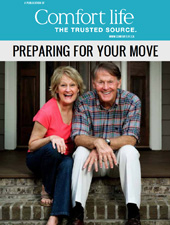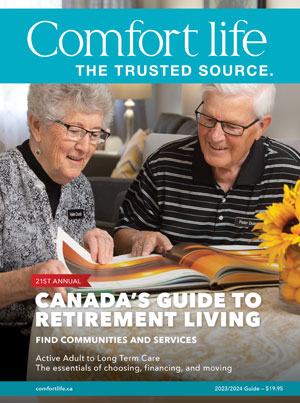What to know about this topic:

In our Inspiring Leaders Series, we interview visionaries driven by a passion for excellence that’s manifest in Canada’s most innovative retirement communities.
view all.
Thought leadership in action at Bria Communities:
When I see people that are happy, when I see people that are engaged in the community … when I walk into any of the communities, and I see that vibrancy, that's exciting! That shows me that the programs that we're implementing [and] providing are working. When people come to meetings, and are speaking up, and are engaged, and feel comfortable and confident as they age, that's exciting!
In the interview transcribed below, Tanya Snow, Director of Bria, discusses her belief that relationships mean everything, and shares how that is expressed in Bria Communities. She also shares her insights into how the senior care sector has evolved, the pride she takes in resident involvement at Bria, and her vision that helps make each community a “vibrant, happy place.”
What is the impact of your role as Director? [0:55]
My role here is to make sure that the general managers at each site have the tools they need to provide high quality of life to the residents who choose to live with us and to choose to make us their final home.
And through that, I make sure that the resources are used effectively. I make sure that issues that arise are addressed as efficiently as possible and make sure that people have an opportunity to be an active part of our communities.
What do you think Bria Communities does really well? [1:30]
I would say the resident involvement. By empowering people to be an active part of the community just results in a very vibrant, happy place. So, you're walking in and you're seeing life! You're seeing people moving and people engaging with each other. And I think that's critical because when someone's making a choice to move in, it's very challenging. Many of them are coming from being alone at home.
Having an environment where they can see that there's a life … that that there's a lot to live for and a vibrancy. And the development of relationships … that's what we've been trying to really work for over the last couple of years. [We want] to make sure that the engagement level and the active communication with everyone—families, residents—is there, so that the information is available when they want it, and they know where to get it.
What has been revolutionary in the industry in the last ten years? [2:35]
One of the greatest challenges, but also greatest rewards, is [in] shifting towards a more concierge-type model of service. The needs of the senior are so unique that it's like an a la carte. You tell us what you want, and it's up to us to make that happen for you, rather than just saying this is what we provide. And these are the walls in which you can have things. Our goal is for us to really stretch what we do so that the things that they need for their individual quality of life is something that we strive to obtain for them.
It can be something small, like having a courtesy vehicle to take them up to their doctor's appointment at the last minute versus having to worry about a cab. Developing relationships with Uber so that maybe that's an alternative form of transportation that we would pay for if the van's not available. [Or] bigger things like: we really want you to invest in putting in proper theatre in our site, so that we can watch movies on the big screen. So, every little request that we get, we should right away say, “OK, well, how are we going to make this happen? Can we make this happen? How will you help us make this happen?”
Having an environment where they can see that there's a life and vibrancy [where there's] development of relationships … that's what we've been trying to really work for over the last couple of years. [We want] to make sure that the engagement level and the active communication with everyone—families, residents—is there.
What are some recent innovations by Bria? [4:00]
We're very transparent with our communication, our website is very dynamic. We have found that by providing up-to-date real information on our website, that that's a place where people could go, in particular, families.
Century Group Corp. is the owner of Bria Communities, along with a private wealth management company. Part of the philosophy around the development of BRIA is looking at multigenerational and integrated opportunities for a community to come together.
So, when we're looking at new BRIA sites, we want to be in an area that's accessible. We want to be in an area that's easy for seniors … senior friendly. So, maybe a senior-friendly community, where they're looking at sidewalks and they're looking at how seniors move in the community.
And it's really important for us to be able to have the opportunity to build where there might be mixed use projects. So, there might be commercial space, there might be a child care, there might be a family housing. All of that is integrated and thought about when we start thinking about a new Bria community … You're part of a bigger picture.
What food service innovations are important to Bria? [5:20]
Our owner, Sean Hodgins, is very passionate about making sure that people feel connected to one another. It's very important for us to have great food as part of our programs, as part of our development. So, some of the some of the Century Group developments will have [farm produce] included. And we at BRIA will be utilizing the produce that's procured in the farm, to bring into our own communities. So we have farm-to-table food, and that's going to be close by, because it's really important for us to be in an environment where we can have community around us, and we feel like we're part of something.
The BRIA Cuisine program has a lot of elements in it. It's about fresh foods. It's about introducing new foods to residents who may never have heard [of something] before. So, if we can find a new vegetable, a watermelon radish, as an example, that no one's ever heard of, [people will wonder] what does that mean and what does that taste like? Part of our programs that we run with, the cuisine and the recreation teams, is the introductions to new foods.
And then we're going to try this on our menu. [The program encourages] the involvement of residents in things like putting together a plate. [We’re] getting residents involved in the decision-making around what they want to eat and why they eat it. So, the chefs [have] got great budgets. If it [requires] spending money on doing a tasting of wine and a wine-pairing program, or bringing in new foods, and doing presentations, then they get to do that.
One of the important things is quality, for us. It's critical to make sure that even though the recipes might be different at each site (depending on what the residents like or ask of the chefs), the type of oven that they use will help produce mass amounts of food at that quality level, where the chefs are focused more on presentation, menu building versus looking at the timer and checking things in an oven. So, just something simple, like having a SMART oven is going to make lives easier and make the food quality a lot better.
This [addresses] choice and the ability to be and remain independent. You're no longer sitting down and looking at three or four items on a menu, and you're stuck with that, and you don't have any other choice. You have to change and add a la carte items. If there's something that someone doesn't like, you're not going to get a frozen TV dinner out of the oven. You're going to get something freshly made. The options are there.
The change that's happened in the industry over the last couple of years is really about making sure that that person's needs are met through food. It might be their only social time of the day. So, the environment has to be comfortable. The choices need to be expansive, [with] options available. Who you're dining with needs to be [appropriate.] We try to really get to know the resident and then be able to help pair them with someone who they might develop a new friendship with.
It's important for us, when someone moves in, that they're going to be eating and spending their time in the dining room, with people who they can communicate well with, that have similar interests as them, that they enjoy that experience with. Because it's not only the food, it's the social aspect of eating and coming together, breaking bread. That's critical, especially if people are interested in group activities or other kind of recreational things. The whole social piece around eating is critical.
What are some forthcoming changes you’re looking forward to launching? [9:35]
As a daughter, I'm helping my mom look for independent living communities. She has certain particular tastes. She's younger than the people that are currently living in Bria right now. But it's the children of the people moving in that are asking questions around what they might like. “Oh, I would love to have that.” We often joke about having a sushi bar because the boomers that are coming into our homes in the next five years or so are going to want [that]. They have a more refined palate, and they are going to have expectations that we are providing right now.
So we have to look to those people that are 10 years younger and understand what their needs are going to be, so we can slowly integrate those options and choices. And it's really going to be, again, about choice and flexibility and different options for dining, and different options for programs and activities … within your community and in the greater community at large.
I know when we build another BRIA, every room is going to have a concierge tablet. They can easily, at one-touch, be able to call reception and have a [face-to-face] conversation, rather than trying to go through a phone. Or [they can] request a service through the tablet, ask for a light bulb change, or [ask for anything].
Whereas, right now, [they're] physically picking up the telephone or calling the reception center, who have to create a work order. And then maintenance comes and it's a process. But being able to have the flexibility to ask for services, ask for assistance just by one touch, is going to change and transform how we do things. It's also going to give us really good indicators as to what the needs of the people living with us are.
We've done some research with some different universities around artificial intelligence and robots in terms of companion robots. We really feel that the person, the human person is what's going to give the best service. We're not saying that technology or the use of companion robots aren't a piece of having a more robust quality of life, but I don't see robotics really replacing anything that we do. It's more enhancing what we do.
How does staff culture impact communities? [12:25]
It comes right down to employee satisfaction. Are they engaged? Are they satisfied with their work environment? It's the same thing as how we engage the residents. If your workstation is not effective for you, what can we do to change it?
Will you tell us your ideas? Tell us what works and what doesn't work. And again, it's the development of strong interpersonal relationships so that the person trusts that their idea is heard or there's no bad idea. So, let's talk about it and let's walk through it together. Employee engagement is critical and employee satisfaction is critical. If we don't have engaged staff, through our leadership, then they're not going to engage the residents.
So it's really comes in how we approach problem solving, how we approach satisfaction, with employees who in turn will be much happier employees, who in turn will be providing a much happier, more robust opportunity for the residents they're serving.
What's going to be most important in the future of senior care? [13:43]
Quality relationships mean everything! Understanding the needs of a human in different stages of their life is critical. When someone is not engaged for some reason, it's up to us to fix that. It's up to us to [give] them something that is going to improve their quality of life.
Throughout this past year [2020-21], we've seen some of those things and we can't ignore that. And we can't ignore loneliness and frailty and fear of being sick. That's part of our obligation, part of our commitment. [We want] to make sure that even if you are making a choice to live in a more isolated way, you're still going to get your meal to your room and it's going to be awesome. You're still going to get visits from us one-on-one, and you're going to still be involved and engaged socially, but it's going to be the way you want it to be.
And that choice and our supporting that choice, whether we agree with it or not, is what we have to continue to provide to the people we serve.
When we're looking at new BRIA sites, we want to be in an area that's accessible. We want to be in an area that's easy for seniors … senior friendly. It's really important for us to build where there might be mixed use projects. So there might be commercial space, there might be a child care, there might be a family housing. … You're part of a bigger picture.
What inspires you? [15:08]
When I see people that are happy, when I see people that are engaged in the community … when I walk into any of the communities, and I see that vibrancy, that's exciting! That shows me that the programs that we're implementing [and] providing are working.
When people come to meetings, and are speaking up, and are engaged, and feel comfortable and confident as they age, that's exciting! And I love new technology. That's exciting! You know, just being able to install active screens that show people what's happening throughout the day, versus wasting paper [or] photocopying posters … having dynamic visual boards, and seeing people look at them and understand and read them? That's exciting. People being engaged and seeing older adults learning new skills like computer skills, which has been critical this past year, it's really exciting!
I think some people think that you get to a certain age and you can't learn anymore. Well, it's such a false statement that people don't have a craving and a desire and a need to be continual learners and grow themselves throughout their whole life.
More about Bria Communities
Bria Communities are found across Greater Vancouver. You can witness how the vision of leaders like Tanya Snow is found in each and every community that falls under this name. Learn more about Bria Communities.




